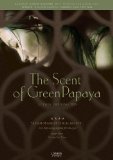| Reviews & Columns |
|
Reviews DVD TV on DVD Blu-ray 4K UHD International DVDs In Theaters Reviews by Studio Video Games Features Collector Series DVDs Easter Egg Database Interviews DVD Talk Radio Feature Articles Columns Anime Talk DVD Savant Horror DVDs The M.O.D. Squad Art House HD Talk Silent DVD
|
DVD Talk Forum |
|
|
| Resources |
|
DVD Price Search Customer Service #'s RCE Info Links |
|
Columns
|
|
|
Scent of Green Papaya, The
Lorber // Unrated // April 26, 2011
List Price: $24.95 [Buy now and save at Amazon]
The Film:
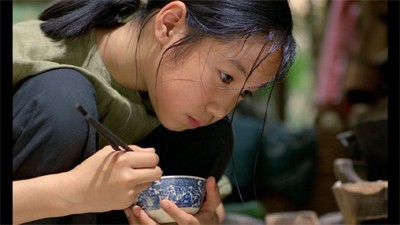 As an artistic medium, film typically communicates in two ways: through narrative, and through sensory reaction. Most movies spin stories and expand on characters, yet others -- notably the works of Nicholas Roeg (Walkabout) and Terrence Malick (Days of Heaven) -- rely on organic artistic flourishes to navigate tone, creating intuitive aural and visual poems intended for feeling instead of word-created depth. Like the harshness Roeg frames in the outback and Malick's fertile yet bleak splendor in rolling fields, Vietnam's Oscar-nominated The Scent of Green Papaya shifts its glances between emerald-hued plants and earthy textures to capture the life of a young servant girl in early-50s Saigon. It allows the atmosphere's lush radiance to guide the film's tone in place of a deeply-layered tale, which encapsulates a pure slice of class-based life in a moody, stimulating light.
As an artistic medium, film typically communicates in two ways: through narrative, and through sensory reaction. Most movies spin stories and expand on characters, yet others -- notably the works of Nicholas Roeg (Walkabout) and Terrence Malick (Days of Heaven) -- rely on organic artistic flourishes to navigate tone, creating intuitive aural and visual poems intended for feeling instead of word-created depth. Like the harshness Roeg frames in the outback and Malick's fertile yet bleak splendor in rolling fields, Vietnam's Oscar-nominated The Scent of Green Papaya shifts its glances between emerald-hued plants and earthy textures to capture the life of a young servant girl in early-50s Saigon. It allows the atmosphere's lush radiance to guide the film's tone in place of a deeply-layered tale, which encapsulates a pure slice of class-based life in a moody, stimulating light.
Director Tran Ang Hung starts by secretly following the focal young girl, Mui (Man San Lu), as she weaves through the dark, peaceful alleys of a populated corner of Vietnam, where she's lugging her belongings to her new position as an odd-and-end servant for a wealthy two-child family. Once there, she's welcomed with open arms; she learns how to stir-fry food from the elder servant, picks up on why the family's quiet grandmother always stays in her room, and deals with the mischievous shenanigans of the youngest troublemaking son. Soon, she becomes an integral part of their dynamic, showing how she elevates her status to something between an employee and a member of their family -- having conversations with the neighbors about the grandmother's reclusion, learning how to stretch out their food in leaner times, and enduring the heartache that befalls their storied life.
The Scent of Green Papaya maintains delicate realism as the camera captures things like food sizzling in pans, creamy secretions dropping on leaves, and aged photographs draped in candlelight. French cinematographer Benoît Delhomme -- more recently known for his work with Mikael Håfström and in John Hillcoat's gritty western The Proposition -- steeps Tran Anh Hung's quiet poetic imagery in earthy intimacy, switching from immersion to meaningfulness in the jumps between young Mui and the eldest son. There's a concurrent scene that's stunning: Mui gleefully glances at an ant crawling over dust and debris while they eat, while the elder son drips candle wax on other ants and crushes them with a fingernail. Some might see symbolism over which one respects life and doesn't, but that'd suggest force behind the director's intentions that doesn't befit its free-flowing nature. The director offers the beautiful images, perhaps hinting at a need for the boy to act out, and simply lets them wash over us. And it's beautiful in its meaningful simplicity.
The story that supports the involving aesthetic mood, however, can best be described as a tender and toned-down melodrama that, in actuality, is supported by the visual mood more than the other way around. It tracks the mental strife that accompanies the death of a family member, highlighting the shifting emotional fabric in the house as their mental and financial stability shifts. Tran Anh Hung emphasizes the stirring pain that fills the open-aired home at several moments, then the emotional exhale that follows, insistently framing the body language and facial reactions of the family members against the fertile life that cradles the Vietnamese home. In this breezy atmosphere, their cohabitation reflects on the bonds built when human nature allows, even with a bratty little boy maliciously back-tracking the servant's work with nagging antics. That's not to say that The Scent of Green Papaya leans on dramatic indulgence, though; the skill present in the restrained direction keeps that from happening.
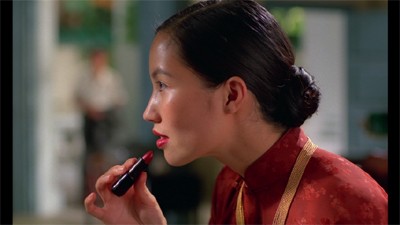 At least, all that I've said to this point covers the first half of The Scent of Green Papaya, as the story vaults ahead nearly a decade to when Mui's a grown (and strikingly beautiful) woman. Everything that gave luster to the chronicling of the young servant's life continues, yet the location and circumstances change and, in the process, some of the inherent dramatic beauty doesn't follow. Mui eventually leaves to serve a concert pianist whom she met (and, with twinkling eyes, adored) at a young age, where she cooks and cleans in a ritzier closed-in location, all under the watchful eye of the man and his fiancé. As she gingerly arranges plates of food she's carefully prepared and watches the man she once had a crush on, the film develops a noticeably different, adult posture. Luckily, Tran Nu Yên-Khê (also Tran Anh Hung's wife) enchants with her radiant beauty and a magnetic mix of innocence and maturity, a deceptively simple performance which reminds that it's the same girl as before, only with years under her belt.
At least, all that I've said to this point covers the first half of The Scent of Green Papaya, as the story vaults ahead nearly a decade to when Mui's a grown (and strikingly beautiful) woman. Everything that gave luster to the chronicling of the young servant's life continues, yet the location and circumstances change and, in the process, some of the inherent dramatic beauty doesn't follow. Mui eventually leaves to serve a concert pianist whom she met (and, with twinkling eyes, adored) at a young age, where she cooks and cleans in a ritzier closed-in location, all under the watchful eye of the man and his fiancé. As she gingerly arranges plates of food she's carefully prepared and watches the man she once had a crush on, the film develops a noticeably different, adult posture. Luckily, Tran Nu Yên-Khê (also Tran Anh Hung's wife) enchants with her radiant beauty and a magnetic mix of innocence and maturity, a deceptively simple performance which reminds that it's the same girl as before, only with years under her belt.
See, but that's the unfortunate pitfall to a story like The Scent of Green Papaya: it slipstreams restrained dramatic moments within the impeccable natural photography, yet the underwritten characters ultimately cannot prop up the weight of bigger dramatic moments. The last leg of the picture serves as something of a cathartic full-circle pivot for Mui, showing how the young girl who gobbled on food from her rice bowl and cared for crickets becomes a full-fledged woman in the midst of a man she's attracted to, and the picture ends on a somewhat brusque, forced emotional note that undermines the eloquent path of growth Tran Anh Hung had paved beforehand. But even in its more uncertain moments, there's still a whirlwind of beauty to fixate on and get emotionally caught up in, such as simple shots of the now-grown woman applying lipstick while in a bright-red dress given to her by someone special. These moments, well-framed and reflective on the path that the girl's traversed, still seduce our responses up until the end.
The DVD:
Video and Audio:
What Kino-Lorber have done with The Scent of Green Papaya borders on the miraculous. Framed at its proper aspect ratio of 1.66:1 and enhanced for widescreen television, the sheer precision encapsulated in this transfer of a early-'90s Vietnamese film might just literally cause one's jaw to drop on a few occasions. There isn't a negative thing to say; fine detail shows off minute, coarse granules in dirt, frog's skin and fabric textures, while color fluctuations in contrast allows the vibrant palette to absolutely pop, yet stay naturally controlled. A noticeable veil of film grain can be seen, something that you don't see all that often in standard-definition presentations, while the focus on black levels in contrast remains dark and stable while never forcing out detail. These are the ingredients that typically make up a quality Blu-ray transfer, only they're present in standard-definition (and, to be frank, I've seen quite a few HD transfers that don't compare to this).
Absolutely no digital manipulation or, for that matter, dust/speckles could be found while scrutinizing the image, aside from the ever-so-slight flatness in a small handful of scenes caused by the resolution's limitations, while the sheen against water and moist skin remains staggering. Quite simply, it's a reminder that standard-definition discs still have a viable pulse, and that the modern tools used for high-definition masters can output exceptional standard-definition renderings. In short, it's about as perfect as the format can get. Below, two sets of still shots have been included that compare the DVD's transfer with the trailer included on the disc. Though that comparison's fairly inconsequential -- given that the trailer's content wasn't preserved with quality in mind -- it's marvelous to see a before-after comparison of this caliber, and it'll give you an idea of what's offered here. (Unfortunately, the 2001 DVD wasn't available for comparison.)
Note: Click on each image for a full-sized screen capture.
The Vietnamese 2.0 Stereo track can only play second fiddle to the visual treatment, but Kino-Lorber made sure that it plays just as big a part in the sensory delight. Ambient sounds like crickets and birds hemming and hawing, the sizzle of food in a pan, the tapping of a prayer woodblock, and the random sounds of a bustling market all pour through with razor-sharp clarity, yet also with fine awareness of the space in which they're located. Dialogue hit a broad spectrum high- and mid-level tones in the film, which are supported competently, while the scintillating orchestral accompaniments test the threshold of the soundtrack to immense successes. A light amount of hiss and age can be intermittently heard in the twang of the track, but otherwise it's pretty exquisite aural delivery. Subtitles arrive in clear, extremely well-translated English text, though it's the only language option available.
Special Features:
Aside from a Stills gallery and a quick but effective Theatrical Trailer (:56, 16x9), Kino-Lorber have also included a Behind the Scenes Featurette(12:40, 4x3). What you'll get is a mix of scenes from the film and on-set footage, painting the picture of the size of the crew while offering a few glimpses at Tran Anh Hung's directorial style and the art department's work. No interviews with the director or much commentary at all can be heard, so it's a pretty dry, surface-level experience that wears think relatively quick. Its biggest accomplishment comes in revealing exactly how much of the village was constructed via production/set work, which, to say the least, was more extensive than one might imagine -- or that one might figure while watching its seamless usage in the film.
Final Thoughts:
Even the title The Scent of Green Papaya suggests something pleasantly subtle, which perfectly describes Tran Anh Hung's vibrant portrait of a servant girl in '50s Vietnam. It's a sublime exercise in the effectiveness of gorgeous cinematography and aural design as a means of storytelling, allowing the organic atmosphere around the locations to dictate the dramatic rhythm, all while communicating a straightforward but effective tale of a girl who grows up while working in a class-based environment. A sensory film like this one should have a quality home release to communicate the splendor that stirs in its composition, and Kino-Lorber's DVD does an incredible job of presenting the film in as beautiful and accurate a fashion as possible -- including what's easily going to be one of 2011's very best standard-definition transfers. Highly Recommended
Thomas Spurlin, Staff Reviewer -- DVDTalk Reviews | Personal Blog/Site
 As an artistic medium, film typically communicates in two ways: through narrative, and through sensory reaction. Most movies spin stories and expand on characters, yet others -- notably the works of Nicholas Roeg (Walkabout) and Terrence Malick (Days of Heaven) -- rely on organic artistic flourishes to navigate tone, creating intuitive aural and visual poems intended for feeling instead of word-created depth. Like the harshness Roeg frames in the outback and Malick's fertile yet bleak splendor in rolling fields, Vietnam's Oscar-nominated The Scent of Green Papaya shifts its glances between emerald-hued plants and earthy textures to capture the life of a young servant girl in early-50s Saigon. It allows the atmosphere's lush radiance to guide the film's tone in place of a deeply-layered tale, which encapsulates a pure slice of class-based life in a moody, stimulating light.
As an artistic medium, film typically communicates in two ways: through narrative, and through sensory reaction. Most movies spin stories and expand on characters, yet others -- notably the works of Nicholas Roeg (Walkabout) and Terrence Malick (Days of Heaven) -- rely on organic artistic flourishes to navigate tone, creating intuitive aural and visual poems intended for feeling instead of word-created depth. Like the harshness Roeg frames in the outback and Malick's fertile yet bleak splendor in rolling fields, Vietnam's Oscar-nominated The Scent of Green Papaya shifts its glances between emerald-hued plants and earthy textures to capture the life of a young servant girl in early-50s Saigon. It allows the atmosphere's lush radiance to guide the film's tone in place of a deeply-layered tale, which encapsulates a pure slice of class-based life in a moody, stimulating light. Director Tran Ang Hung starts by secretly following the focal young girl, Mui (Man San Lu), as she weaves through the dark, peaceful alleys of a populated corner of Vietnam, where she's lugging her belongings to her new position as an odd-and-end servant for a wealthy two-child family. Once there, she's welcomed with open arms; she learns how to stir-fry food from the elder servant, picks up on why the family's quiet grandmother always stays in her room, and deals with the mischievous shenanigans of the youngest troublemaking son. Soon, she becomes an integral part of their dynamic, showing how she elevates her status to something between an employee and a member of their family -- having conversations with the neighbors about the grandmother's reclusion, learning how to stretch out their food in leaner times, and enduring the heartache that befalls their storied life.
The Scent of Green Papaya maintains delicate realism as the camera captures things like food sizzling in pans, creamy secretions dropping on leaves, and aged photographs draped in candlelight. French cinematographer Benoît Delhomme -- more recently known for his work with Mikael Håfström and in John Hillcoat's gritty western The Proposition -- steeps Tran Anh Hung's quiet poetic imagery in earthy intimacy, switching from immersion to meaningfulness in the jumps between young Mui and the eldest son. There's a concurrent scene that's stunning: Mui gleefully glances at an ant crawling over dust and debris while they eat, while the elder son drips candle wax on other ants and crushes them with a fingernail. Some might see symbolism over which one respects life and doesn't, but that'd suggest force behind the director's intentions that doesn't befit its free-flowing nature. The director offers the beautiful images, perhaps hinting at a need for the boy to act out, and simply lets them wash over us. And it's beautiful in its meaningful simplicity.
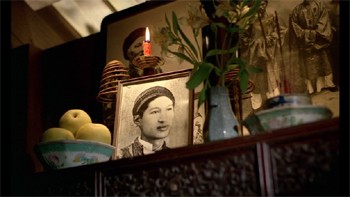 | 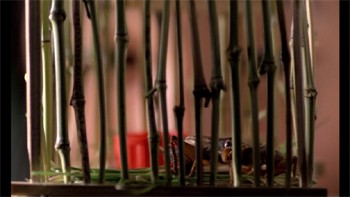 |
The story that supports the involving aesthetic mood, however, can best be described as a tender and toned-down melodrama that, in actuality, is supported by the visual mood more than the other way around. It tracks the mental strife that accompanies the death of a family member, highlighting the shifting emotional fabric in the house as their mental and financial stability shifts. Tran Anh Hung emphasizes the stirring pain that fills the open-aired home at several moments, then the emotional exhale that follows, insistently framing the body language and facial reactions of the family members against the fertile life that cradles the Vietnamese home. In this breezy atmosphere, their cohabitation reflects on the bonds built when human nature allows, even with a bratty little boy maliciously back-tracking the servant's work with nagging antics. That's not to say that The Scent of Green Papaya leans on dramatic indulgence, though; the skill present in the restrained direction keeps that from happening.
 At least, all that I've said to this point covers the first half of The Scent of Green Papaya, as the story vaults ahead nearly a decade to when Mui's a grown (and strikingly beautiful) woman. Everything that gave luster to the chronicling of the young servant's life continues, yet the location and circumstances change and, in the process, some of the inherent dramatic beauty doesn't follow. Mui eventually leaves to serve a concert pianist whom she met (and, with twinkling eyes, adored) at a young age, where she cooks and cleans in a ritzier closed-in location, all under the watchful eye of the man and his fiancé. As she gingerly arranges plates of food she's carefully prepared and watches the man she once had a crush on, the film develops a noticeably different, adult posture. Luckily, Tran Nu Yên-Khê (also Tran Anh Hung's wife) enchants with her radiant beauty and a magnetic mix of innocence and maturity, a deceptively simple performance which reminds that it's the same girl as before, only with years under her belt.
At least, all that I've said to this point covers the first half of The Scent of Green Papaya, as the story vaults ahead nearly a decade to when Mui's a grown (and strikingly beautiful) woman. Everything that gave luster to the chronicling of the young servant's life continues, yet the location and circumstances change and, in the process, some of the inherent dramatic beauty doesn't follow. Mui eventually leaves to serve a concert pianist whom she met (and, with twinkling eyes, adored) at a young age, where she cooks and cleans in a ritzier closed-in location, all under the watchful eye of the man and his fiancé. As she gingerly arranges plates of food she's carefully prepared and watches the man she once had a crush on, the film develops a noticeably different, adult posture. Luckily, Tran Nu Yên-Khê (also Tran Anh Hung's wife) enchants with her radiant beauty and a magnetic mix of innocence and maturity, a deceptively simple performance which reminds that it's the same girl as before, only with years under her belt. See, but that's the unfortunate pitfall to a story like The Scent of Green Papaya: it slipstreams restrained dramatic moments within the impeccable natural photography, yet the underwritten characters ultimately cannot prop up the weight of bigger dramatic moments. The last leg of the picture serves as something of a cathartic full-circle pivot for Mui, showing how the young girl who gobbled on food from her rice bowl and cared for crickets becomes a full-fledged woman in the midst of a man she's attracted to, and the picture ends on a somewhat brusque, forced emotional note that undermines the eloquent path of growth Tran Anh Hung had paved beforehand. But even in its more uncertain moments, there's still a whirlwind of beauty to fixate on and get emotionally caught up in, such as simple shots of the now-grown woman applying lipstick while in a bright-red dress given to her by someone special. These moments, well-framed and reflective on the path that the girl's traversed, still seduce our responses up until the end.
The DVD:
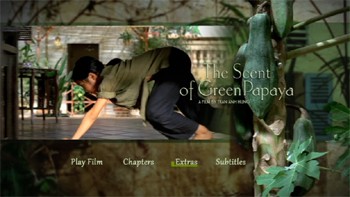 | 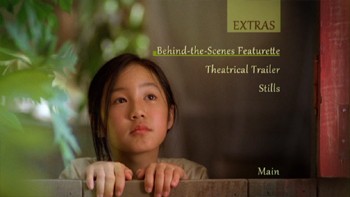 |
Video and Audio:
What Kino-Lorber have done with The Scent of Green Papaya borders on the miraculous. Framed at its proper aspect ratio of 1.66:1 and enhanced for widescreen television, the sheer precision encapsulated in this transfer of a early-'90s Vietnamese film might just literally cause one's jaw to drop on a few occasions. There isn't a negative thing to say; fine detail shows off minute, coarse granules in dirt, frog's skin and fabric textures, while color fluctuations in contrast allows the vibrant palette to absolutely pop, yet stay naturally controlled. A noticeable veil of film grain can be seen, something that you don't see all that often in standard-definition presentations, while the focus on black levels in contrast remains dark and stable while never forcing out detail. These are the ingredients that typically make up a quality Blu-ray transfer, only they're present in standard-definition (and, to be frank, I've seen quite a few HD transfers that don't compare to this).
Absolutely no digital manipulation or, for that matter, dust/speckles could be found while scrutinizing the image, aside from the ever-so-slight flatness in a small handful of scenes caused by the resolution's limitations, while the sheen against water and moist skin remains staggering. Quite simply, it's a reminder that standard-definition discs still have a viable pulse, and that the modern tools used for high-definition masters can output exceptional standard-definition renderings. In short, it's about as perfect as the format can get. Below, two sets of still shots have been included that compare the DVD's transfer with the trailer included on the disc. Though that comparison's fairly inconsequential -- given that the trailer's content wasn't preserved with quality in mind -- it's marvelous to see a before-after comparison of this caliber, and it'll give you an idea of what's offered here. (Unfortunately, the 2001 DVD wasn't available for comparison.)
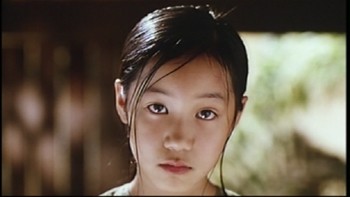 | 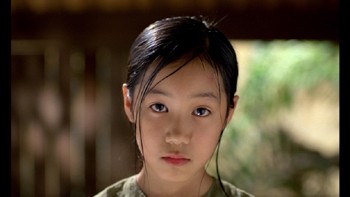 |
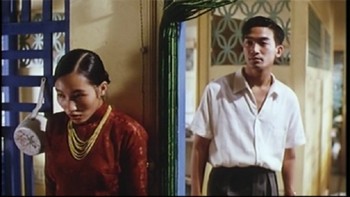 | 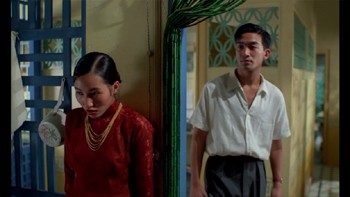 |
The Vietnamese 2.0 Stereo track can only play second fiddle to the visual treatment, but Kino-Lorber made sure that it plays just as big a part in the sensory delight. Ambient sounds like crickets and birds hemming and hawing, the sizzle of food in a pan, the tapping of a prayer woodblock, and the random sounds of a bustling market all pour through with razor-sharp clarity, yet also with fine awareness of the space in which they're located. Dialogue hit a broad spectrum high- and mid-level tones in the film, which are supported competently, while the scintillating orchestral accompaniments test the threshold of the soundtrack to immense successes. A light amount of hiss and age can be intermittently heard in the twang of the track, but otherwise it's pretty exquisite aural delivery. Subtitles arrive in clear, extremely well-translated English text, though it's the only language option available.
Special Features:
Aside from a Stills gallery and a quick but effective Theatrical Trailer (:56, 16x9), Kino-Lorber have also included a Behind the Scenes Featurette(12:40, 4x3). What you'll get is a mix of scenes from the film and on-set footage, painting the picture of the size of the crew while offering a few glimpses at Tran Anh Hung's directorial style and the art department's work. No interviews with the director or much commentary at all can be heard, so it's a pretty dry, surface-level experience that wears think relatively quick. Its biggest accomplishment comes in revealing exactly how much of the village was constructed via production/set work, which, to say the least, was more extensive than one might imagine -- or that one might figure while watching its seamless usage in the film.
Final Thoughts:
Even the title The Scent of Green Papaya suggests something pleasantly subtle, which perfectly describes Tran Anh Hung's vibrant portrait of a servant girl in '50s Vietnam. It's a sublime exercise in the effectiveness of gorgeous cinematography and aural design as a means of storytelling, allowing the organic atmosphere around the locations to dictate the dramatic rhythm, all while communicating a straightforward but effective tale of a girl who grows up while working in a class-based environment. A sensory film like this one should have a quality home release to communicate the splendor that stirs in its composition, and Kino-Lorber's DVD does an incredible job of presenting the film in as beautiful and accurate a fashion as possible -- including what's easily going to be one of 2011's very best standard-definition transfers. Highly Recommended
|
| Popular Reviews |
| Sponsored Links |
|
|
| Sponsored Links |
|
|
| Release List | Reviews | Shop | Newsletter | Forum | DVD Giveaways | Blu-Ray | Advertise |
|
Copyright 2024 DVDTalk.com All Rights Reserved. Legal Info, Privacy Policy, Terms of Use,
Manage Preferences,
Your Privacy Choices | |||||||









